History of Marin Agriculture
View the Marin Ag History Banner & learn about Marin's 1st Farm Advisor, M.B. Boissevain
Agriculture has been an important part of west Marin culture since the mid 19th century. In the early 1820s Marin was settled by the Mexicans or Californnios, whose home base was the San Rafael mission. The Mexicans raised thousands of longhorn cattle for their hides and tallow. The cattle ran wild along with herds of native tule elk and were rounded up yearly by Mexican and Miwok vaqueros. By then the Catholic missionaries had rounded up the native population of coastal Miwok peoples and forcibly moved them to missions.
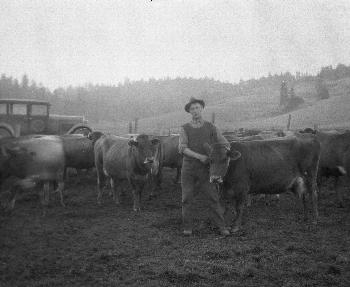
After the mission was shut down in 1834, the land and the longhorns were divided up into vast ranchos. During the Gold Rush of 1849, the longhorns were driven to the gold country. After the Gold Rush faded, ranchers began to introduce American stock to replace the Mexican cattle and the tule elk, wiped out by hunting and loss of habitat.
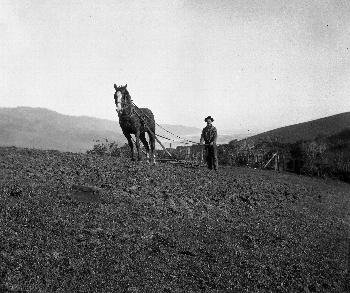
The Gold Rush of 1849 helped start the dairy industry. In the 1850s a San Francisco law firm owned most of the Point Reyes peninsula and established several very successful tenant ranches. These kinds of dairy ranches, owned by absentee landowners, were also set up in Sausalito. They not only produced dairy products, but huge crops of fruit.
At that time, most dairy operations were small, 10 to 15 cows, or as many as they could milk by hand. Cows were milked twice a day.
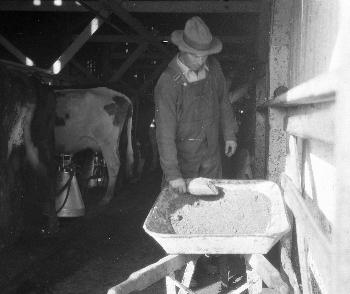
Before refrigeration, all the milk produced was churned into butter. In 1862 Marin provided a quarter of California's butter. Fresh milk was poured into pans and cooled. The cream was skimmed from the top, churned into butter and salted to preserve it. Some families made their own cheese or used the skills of a cheesemaker who traveled from ranch to ranch. Since land travel was limited to horse trails and wagon roads, creeks and waterways were the major links to the San Francisco market.
The Marin coastal towns of Bolinas and Tomales were shipping ports for agricultural products. Tons of potatoes, grains, clams and dairy products like cheese and butter were shipped from warehouses to eager markets in San Francisco.
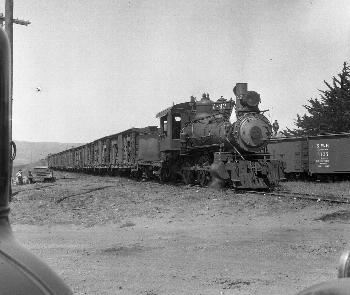
Flat-bottomed hay schooners were important boats for moving hay to hungry San Francisco horses and livestock. They also carried wheat and barley, vegetables, salt, dairy products, lumber and bricks from Marin brickyards. One can visit the Alma, a restored schooner now at the National Historical Park in San Francisco. Ross Landing in Kentfield was one of Marin's busiest ports until the trains came in the 1880s.
Oyster culture is the oldest aquaculture industry in California, dating back to the 1850s.Marin is second only to Humboldt Bay in California in shellfish production, which includes oysters, clams, and mussels.
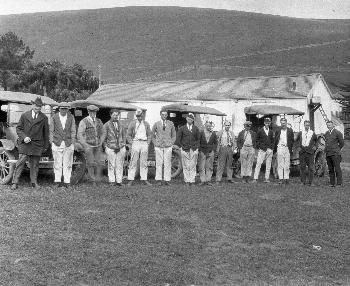
Immigrants from Ireland, the Italian-Swiss mountain country, Portugal and the Azores, and other countries established family farms that are still a vital part of the local economy. Towns like Tomales, Olema and Nicasio were early trading centers for Marin's growing dairy ranches. Potatoes were a huge crop in the Tomales area from the 1850s to 1900. The steep hillsides planted in vertical row crops couldn't take the intensive cultivation, and the resulting erosion caused tremendous sedimentation of Tomales Bay, the Esteros and Key's Creek.
In 1870 the North Pacific coast railroad was completed, traversing Marin and connecting coastal towns to San Francisco. All kinds of agricultural products traveled south on the railroad. Towns along the railroad (Fairfax, Mill Valley, San Rafael) blossomed, while those bypassed by the trains froze in time. In 1868 there were 4,000 acres of potatoes, 11,000 acres of grass hay, 750 acres of beets, and 4,360 apple trees.
Since the 1800s, when dairying developed in Marin, the dairy industry has been known for its high-quality delicious milk. The invention of the milk bottle in 1884 made handling and distribution of milk much easier. The California Cooperative Creamery was established in 1913 by local milk producers to process and distribute the milk products (milk, butter, cheese).
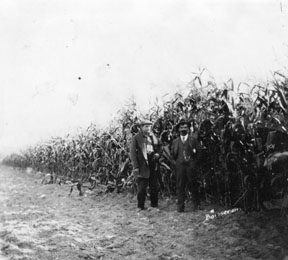
But milk products is not the only historical profit center for Marin farmers and ranchers. In 1939, 875 acres of dryfarmed artichoke fields produced 81,000 crates.
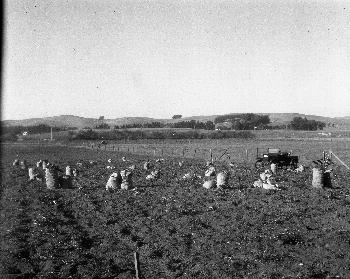
"Our climate is especially adapted to this crop and it could and should be expanded as we have plenty of acres along our coast in Marin County that could be used for artichoke production."- Thomas N. Peryam, Agricultural Commissioner, 1940 crop report.
At one time Marin County had 2,000 acres of peas planted. There was, at one time, a flourishing cut flower industry and also many nurseries.
Preserving Agriculture
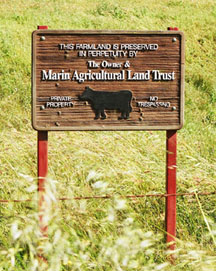
Between 1949 and 1982 about 783,000 acres, or roughly one-quarter of the Bay Area's farmland, was lost. Since 1959 Marin has lost 32,000 acres of agricultural lands. (1944 census figures show 1,800 ranches, as compared to 276 today.)
In the early 1970s, Marin's agriculture was threatened when plans for major highway extensions to the coast were developed. The county was rezoned to include three major planning corridors, of which two - the coastal recreation and inland rural corridors - contain most of the agriculture in Marin today. They are protected by A-60 zoning, which allows no more that one house per 60 acres.
In 1950 there were 200 dairy ranches in Marin. There were 150 in 1960 and fewer than 100 in 1972. A group of ranchers and local environmentalists came together to create the Marin Agricultural Land Trust as a way of preserving agricultural lands. Since MALT's beginning in 1980, it has acquired agricultural conservation easements on over 41,800 acres, protecting and keeping those lands forever in agriculture. See the MALT web site for more details at www.malt.org.



